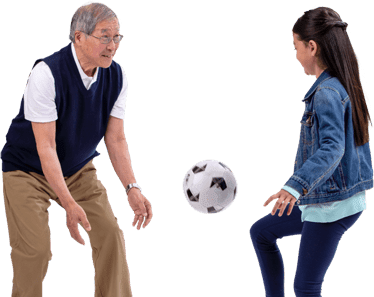DETECTING PROSTATE
CANCER. CLEARLY.


Not an actual patient.
Based on the initial diagnosis assessment or if the prostate cancer has come back (also known as a recurrence), it’s important to know if and where the prostate cancer has spread—or metastasized. That’s where imaging comes in. It can play a vital role in helping to detect and monitor prostate cancer progression. However, not all imaging scans are the same. While many of the current options—such as bone, CT, and MRI scans—provide some important information, they also have limitations.
A PET scan is often combined with a CT scan for better diagnostic accuracy. Compared to conventional imaging, a PET/CT scan with PYLARIFY® (piflufolastat F 18) injection provides you and your doctor a clearer image of where the prostate cancer is and helps your doctor make more informed treatment choices.
What is a PET scan?
A PET scan is an imaging test that helps doctors look for disease in the body. A PET scan uses an imaging agent—like PYLARIFY®—that contains a small amount of radioactive tracer, which targets cancer cells. Once there, the imaging agent lights up, helping the reader of the PET scan find the disease location, usually before tumors appear on other types of imaging scans.
What is PYLARIFY®?
PYLARIFY® is an advanced diagnostic imaging agent used with PET/CT scans to find tumors in the prostate, lymph nodes, bones, and other organs, typically better than other types of imaging scans.
How does PYLARIFY® work?
PYLARIFY® attaches to prostate-specific membrane antigen (PSMA), a protein found on the surface of most—approximately 95%—prostate cancer cells. By targeting PSMA, PYLARIFY® can give your doctor a clear image and additional information on the location and extent of the cancer.
PYLARIFY® helps create
clearer images for your doctor
PYLARIFY® uses a radioactive tracer called fluorine-18, or 18F, which helps create a clear and more detailed PET/CT scan image for your doctor. A clearer image also provides improved insights, which can lead to more informed treatment choices.
PYLARIFY® PET/CT SCAN vs OTHER CONVENTIONAL IMAGING


*Although a PET scan has some limitations when detecting microscopic metastases, it can detect smaller metastases compared to CT or MRI.
†PSA <2 ng/mL.
CT=computed tomography; MRI=magnetic resonance imaging; NA=not applicable, can only detect cancer in bones; PET=positron emission tomography; PSA=prostate-specific antigen.
PYLARIFY® is an imaging agent for PET/CT scans that uses a unique combination of a PSMA-targeted small molecule and the radioactive tracer 18F to help your doctor make more informed treatment choices based on clear images. PYLARIFY® may help detect metastases even when PSA levels are low.
MEDICAL RADIATION
IS COMMON
Every day, we’re exposed to various forms of environmental radiation, mainly in the form of vegetation, foods, and air travel. When you undergo a PET/CT scan, you’re exposed to a man-made form called medical radiation, which is used for diagnostic purposes. These procedures are common in the US. In fact, 20 million diagnostic procedures—such as PET scans, CT scans, bone scans, and X-rays—use medical radiation in the US every year.
If you have questions about radiation, please speak to your doctor.
IN CLINICAL TRIALS, PYLARIFY® WAS WELL TOLERATED
Side effects of PYLARIFY® were minor and rare. The most common side effects were headache (2% of patients), unusual taste (2% of patients), and fatigue (1% of patients). In addition, a hypersensitivity reaction was reported in 1 patient (0.2%) with a history of allergic reactions.

To see if a PET/CT scan with PYLARIFY® is right for you, talk with your doctor. Not sure what to ask? We’ve put together a list of questions to help guide the discussion.
PYLARIFY tells your doctor what they need to know
PYLARIFY helps to show where prostate cancer is in the body to help guide the next steps in your treatment
The clear difference with PYLARIFY
PSMA PET with PYLARIFY is not like standard imaging. It can detect prostate cancer in bones and soft tissue—even when the tumors are smaller or when standard imaging isn’t able to detect cancer.*
PSMA PET scan with PYLARIFY vs standard imaging
Pinch to zoom
*While a PET scan might miss very tiny areas of cancer, it can still find smaller spots than a CT or MRI scan.
†PSA <2 ng/mL.
What is "standard" imaging?
Examples of standard imaging include:
CT (computerized tomography)
Uses X-rays to create images that show the shape, size, and locations of the organs and tissues
It does not target cancer, but a doctor may spot an abnormality
MRI (magnetic resonance imaging)
Uses radio waves and strong magnets to create images of organs in the body
This scan cannot specifically target cancer and can’t be used in people with pacemakers or artificial joints
Bone scan
Uses a small amount of radioactive material that collects in the bones and becomes visible in a scan
While it can show changes in bone, it is not designed to detect cancer specifically
APPROVED USE
PYLARIFY® (piflufolastat F 18) Injection is a radioactive diagnostic agent. PYLARIFY is used along with positron emission tomography (PET) imaging for men with prostate cancer:
- with suspected metastasis who are candidates for initial definitive therapy.
- with suspected recurrence based on elevated serum levels of prostate-specific antigen (PSA) level.
PYLARIFY Injection is designed to detect prostate-specific membrane antigen (PSMA) positive lesions when used with PET imaging (scans).
IMPORTANT SAFETY INFORMATION
How well does PYLARIFY work?
- As with all diagnostic imaging tests such as X-rays, bone scans, and computed tomography (CT) scans, it is possible that the physician (a radiologist or nuclear medicine physician) who reviews your PYLARIFY PET/CT scan could interpret your results incorrectly. This means that a negative PYLARIFY PET/CT scan does not rule out that you have prostate cancer, and a positive PYLARIFY PET/CT scan does not confirm that you have prostate cancer.
- PYLARIFY seems to be affected by the amount (level) of PSA in your blood. As the levels of PSA in your blood go up, a PYLARIFY PET/CT scan is better able to identify prostate cancer.
Hypersensitivity reactions:
- Patients should be monitored for hypersensitivity reactions, especially those with a history of allergy to other drugs and foods. Reactions may be delayed. Always have trained staff and resuscitation equipment available.
Radiation exposure:
- PYLARIFY is a radioactive diagnostic agent and adds to your long-term overall amount of radiation exposure, which could lead to an increased risk of cancer. You should stay well hydrated before, during, and after you are given PYLARIFY and urinate frequently to reduce radiation exposure.
What are the possible side effects of PYLARIFY?
- There were no serious reactions reported in patients who received scans in clinical trials with PYLARIFY, but some patients did report side effects associated with the use of PYLARIFY.
- The most commonly reported adverse reactions are headache, fatigue, and unusual taste in the mouth. An allergic reaction to PYLARIFY was reported in one patient with a significant history of allergic reactions.
Tell your doctor if you have any side effect that bothers you or does not go away.
You are encouraged to report negative side effects of prescription drugs to the FDA.
Visit www.fda.gov/medwatch or call 1-888-INFO-FDA (1-888-463-6332).
Please read the accompanying full Prescribing Information.
APPROVED USE
PYLARIFY® (piflufolastat F 18) Injection is a radioactive diagnostic agent. PYLARIFY is used along with positron emission tomography (PET) imaging for men with prostate cancer:
- with suspected metastasis who are candidates for initial definitive therapy.
- with suspected recurrence based on elevated serum levels of prostate-specific antigen (PSA) level.
PYLARIFY Injection is designed to detect prostate-specific membrane antigen (PSMA) positive lesions when used with PET imaging (scans).
PYLARIFY® (piflufolastat F 18) Injection is a radioactive diagnostic agent. PYLARIFY is used along with positron emission tomography (PET) imaging for men with prostate cancer:
- with suspected metastasis who are candidates for initial definitive therapy.
- with suspected recurrence based on elevated serum levels of prostate-specific antigen (PSA) level.
PYLARIFY Injection is designed to detect prostate-specific membrane antigen (PSMA) positive lesions when used with PET imaging (scans).
IMPORTANT SAFETY INFORMATION
How well does PYLARIFY work?
- As with all diagnostic imaging tests such as X-rays, bone scans, and computed tomography (CT) scans, it is possible that the physician (a radiologist or nuclear medicine physician) who reviews your PYLARIFY PET/CT scan could interpret your results incorrectly. This means that a negative PYLARIFY PET/CT scan does not rule out that you have prostate cancer, and a positive PYLARIFY PET/CT scan does not confirm that you have prostate cancer.
- PYLARIFY seems to be affected by the amount (level) of PSA in your blood. As the levels of PSA in your blood go up, a PYLARIFY PET/CT scan is better able to identify prostate cancer.
Hypersensitivity reactions:
- Patients should be monitored for hypersensitivity reactions, especially those with a history of allergy to other drugs and foods. Reactions may be delayed. Always have trained staff and resuscitation equipment available.
Radiation exposure:
- PYLARIFY is a radioactive diagnostic agent and adds to your long-term overall amount of radiation exposure, which could lead to an increased risk of cancer. You should stay well hydrated before, during, and after you are given PYLARIFY and urinate frequently to reduce radiation exposure.
What are the possible side effects of PYLARIFY?
- There were no serious reactions reported in patients who received scans in clinical trials with PYLARIFY, but some patients did report side effects associated with the use of PYLARIFY.
- The most commonly reported adverse reactions are headache, fatigue, and unusual taste in the mouth. An allergic reaction to PYLARIFY was reported in one patient with a significant history of allergic reactions.
Tell your doctor if you have any side effect that bothers you or does not go away.
You are encouraged to report negative side effects of prescription drugs to the FDA.
Visit www.fda.gov/medwatch or call 1-888-INFO-FDA (1-888-463-6332).
Please read the accompanying full Prescribing Information.
How well does PYLARIFY work?
- As with all diagnostic imaging tests such as X-rays, bone scans, and computed tomography (CT) scans, it is possible that the physician (a radiologist or nuclear medicine physician) who reviews your PYLARIFY PET/CT scan could interpret your results incorrectly. This means that a negative PYLARIFY PET/CT scan does not rule out that you have prostate cancer, and a positive PYLARIFY PET/CT scan does not confirm that you have prostate cancer.
- PYLARIFY seems to be affected by the amount (level) of PSA in your blood. As the levels of PSA in your blood go up, a PYLARIFY PET/CT scan is better able to identify prostate cancer.
Hypersensitivity reactions:
- Patients should be monitored for hypersensitivity reactions, especially those with a history of allergy to other drugs and foods. Reactions may be delayed. Always have trained staff and resuscitation equipment available.
Radiation exposure:
- PYLARIFY is a radioactive diagnostic agent and adds to your long-term overall amount of radiation exposure, which could lead to an increased risk of cancer. You should stay well hydrated before, during, and after you are given PYLARIFY and urinate frequently to reduce radiation exposure.
What are the possible side effects of PYLARIFY?
- There were no serious reactions reported in patients who received scans in clinical trials with PYLARIFY, but some patients did report side effects associated with the use of PYLARIFY.
- The most commonly reported adverse reactions are headache, fatigue, and unusual taste in the mouth. An allergic reaction to PYLARIFY was reported in one patient with a significant history of allergic reactions.
Tell your doctor if you have any side effect that bothers you or does not go away.
You are encouraged to report negative side effects of prescription drugs to the FDA.
Visit www.fda.gov/medwatch or call 1-888-INFO-FDA (1-888-463-6332).
Please read the accompanying full Prescribing Information.





